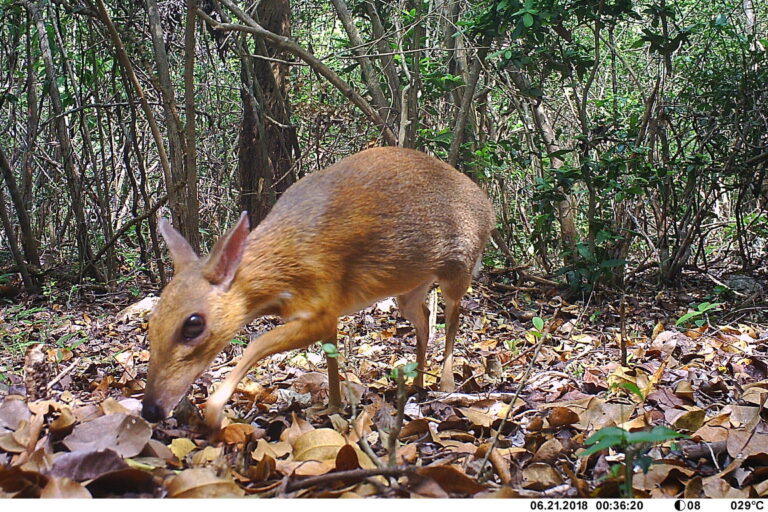- A new camera-trapping study has found several rare and threatened species in Vietnam’s Nui Chua National Park, home to one of mainland Southeast Asia’s last remnants of dry coastal forest.
- However, the findings also indicate intense pressure on wildlife populations within the reserve from habitat fragmentation and snaring.
- The study found a relatively high diversity of species in transitional habitats between different types of forest, indicating a need for more nuanced conservation planning to target localized measures, the authors say.
- The findings reaffirm the importance of Vietnam’s dry coastal forests for biodiversity and the need for strengthened protection to reduce pressure on wildlife from snaring and habitat degradation.
In 2019, scientists rediscovered a species of miniature deer long lost to science within the dry coastal forests of southern Vietnam’s Nui Chua National Park. A victim of snaring, the silver-backed chevrotain (Tragulus versicolor) hadn’t been seen by scientists in the wild for nearly 30 years. Its unearthing via a camera-trapping study sparked a conservation focus on the reserve, contributing to its 2022 designation as a UNESCO World Biosphere Reserve.
Although the resighting was a feat in itself, the scientists were captivated by the diversity of other species turning up in their images. “This inspired us to look beyond the species level and investigate the ground-dwelling mammal and bird community in Nui Chua,” An Nguyen, a member of the deer survey team and Ph.D. student at the Leibniz Institute for Zoo and Wildlife Research in Germany, said in a statement.
Nguyen and his colleagues from Germany, the U.S. and Vietnam embarked on a four-year study of the reserve, setting up 145 camera traps between 2018 and 2022 across a range of habitats ascending from Nui Chua’s coastal dry forests, through semi-dry forests and into its highest-elevation broadleaf wet rainforests.
Nui Chua National Park spans roughly 22,500 hectares (55,600 acres) of coastal mountains in southeast Vietnam’s Ninh Thuan province, within a region known as the Greater Annamites due to its proximity to the Annamite Mountain Range that extends like a spine from southern Vietnam northward along its western border with Cambodia and Laos. Due to the reserve’s unique climatic conditions, it’s home to one of mainland Southeast Asia’s most complete coastal forest ecosystems, where one habitat type blends into another from the sea all the way to the mountains.
However, the reserve’s high-elevation wet rainforests, a habitat that usually supports the highest biodiversity levels in the region, are relatively small and cut off from the wider landscape by agricultural land, roads and settlements. They’re also buckling under increasing tourism pressure. Despite this, biologists have recorded 72 species of mammals, 181 species of birds, 53 reptiles and amphibians, more than 1,000 species of plants, and a plethora of marine and coastal species, including nesting turtles, within the reserve, according to the website of the Ministry of Natural Resources and Environment.

The team found 23 species of forest-floor mammals and birds in total, including Malayan porcupines (Hystrix brachyura), goat-like serows (Capricornis sumatraensis), Siamese fireback pheasants (Lophura diardi), Germain’s peacock pheasants (Polyplectron germaini) and blue-rumped pittas (Hydrornis soror). The cameras also amassed more than 860 detections of the rare silver-backed chevrotain, confirming it still lives in the reserve and providing valuable information about the mysterious species, which currently lacks enough information for the IUCN, the global wildlife conservation authority, to assess its conservation status.
Although the detection of this wide range of species was encouraging, the team uncovered several unusual patterns when it came to the distribution of species across the landscape.
First, the highest number of species were detected in what the researchers call an “ecotone” — a transitional semi-dry habitat between the dry coastal forest and higher-elevation wetter rainforest. Second, in stark contrast with previous studies from the Greater Annamite region, they found Nui Chua’s small and isolated remnants of broadleaf wet rainforest supported the fewest ground-dwelling species.
The authors suggest these unusual patterns could be explained by animals moving between the dry and wet forest types, with the transitional semi-dry zone functioning as an important refugia for species, especially generalists.
A major concern, however, is that many areas of this more open-canopy habitat fall outside of the reserve’s core protected area, making them vulnerable to development, particularly from tourism. The authors have therefore called on the national park authority to strengthen protection of the park’s semi-dry forests through further study and inclusion in the core protection area.
“The fact that the highly threatened silver-backed chevrotain likely has its largest population in the semi-dry forests of Nui Chua provides further urgency for protecting this habitat,” the study says. “Ecologists should pay special attention to transitional ecotone areas.”

Botanical studies from Nui Chua have also found biodiversity value in Nui Chua’s semi-dry ecotone habitats, according to study co-author Hong Truong Luu, a plant biologist at the Vietnam Academy of Science and Technology. Luu was part of a team that in 2023 described a new species of thorny shrub, Balantines vietnamica, from the reserve. He said the semi-dry forests support “exceptionally high” plant diversity and the new findings are further evidence that Vietnam’s dry coastal forests are in need of better protection.
Tommaso Savini, a conservation biologist at King Mongkut’s University of Technology in Thailand, who wasn’t involved in the study, said that while he agrees with the broad conclusions of the study, care must be taken not to overemphasize the importance of the semi-dry forest ecotone at Nui Chua to the point that it could detract from managing the pressures that are limiting wildlife survival in the wet rainforest areas.
Snaring is chief among these threats, Savini said, and is likely the main reason why fewer species were found in Nui Chua’s wet rainforests. “In Vietnam, snares are everywhere, absolutely everywhere,” he said.
According to a 2020 WWF report, an estimated 12 million snares lie in wait throughout protected forests in Cambodia, Laos and Vietnam. Although hunters usually set snares to catch bushmeat, the sheer number left in forests means all manner of wildlife species fall foul of the traps. Studies have also shown that snaring tends to be more intense within denser, more “pristine” rainforests — another reason why Nui Chua’s rainforest biodiversity might be suffering, Savini noted.

The study notes that snaring is likely a major driver of biodiversity decline in Nui Chua, given the camera traps failed to detect medium-size carnivores like masked palm civets (Paguma larvata) and spotted linsangs (Prionodon pardicolor), which are known to live in the surrounding Greater Annamite region.
“If these species historically occurred in the small broadleaf wet evergreen forest area in Nui Chua, their populations were likely small, and thus vulnerable to local extinction,” the study says. “Given the high levels of snaring pressure in Vietnam, it is conceivable that these species were extirpated from hunting.”
Savini said it’s certainly possible to reduce snaring pressure at Nui Chua and see wildlife return to the denser rainforest areas. He cited examples across Southeast Asia where concerted snare removal patrolling by park rangers have led to biodiversity recovery, such as at Huai Kha Kaheng Wildlife Sanctuary in Thailand where numbers of tigers and their prey are increasing; and at Cát Tiên National Park in Vietnam, where birds and langurs are in recovery following hunting management.
“To do this, you need willingness from the government level,” Savini said. “If the government sets up a protected area and then doesn’t actively try to protect it by deploying rangers and patrolling programs and so on, then it can be of limited success.”
As mainland Southeast Asia’s most complete example of dry coastal forests and the world’s only home to the mysterious silver-backed chevrotain, Nui Chua National Park should be able to attract the necessary willingness for greater conservation investment, according to Savini.
“If you show there is something valuable,” he said, “there is a higher chance that you can get better support.”
Banner image: A silver-backed chevrotain photographed by a camera trap in Nui Chua National Park. Image courtesy of Leibniz-IZW/Nui Chua NP/SIE.
Carolyn Cowan is a staff writer for Mongabay.
Citations:
Nguyen, A., Tilker, A., Le, Q. T., Nguyen, M., Tran, V. T., Luu, H. T., … Wilting, A. (2025). Ecotones shape ground‐dwelling mammal and bird diversity along a habitat gradient in the southern coastal dry forests of Vietnam. Biotropica, 57(1). doi:10.1111/btp.13422
Nguyen, A., Tran, V. B., Hoang, D. M., Nguyen, T. A., Nguyen, D. T., Tran, V. T., … Tilker, A. (2019). Camera-trap evidence that the silver-backed chevrotain Tragulus versicolor remains in the wild in Vietnam. Nature Ecology & Evolution, 3(12), 1650-1654. doi:10.1038/s41559-019-1027-7
Nguyen, T. Q., Nguyen, T. T., Van Tiep Tran, & Luu, H. T. (2023). Balantines vietnamica (Zygophyllaceae), a new species from Vietnam. Academia Journal of Biology, 45(1), 55-64. doi:10.15625/2615-9023/17706
See related story:
Vietnam’s mammals need conservation within and outside their range: Study
FEEDBACK: Use this form to send a message to the author of this post. If you want to post a public comment, you can do that at the bottom of the page.







